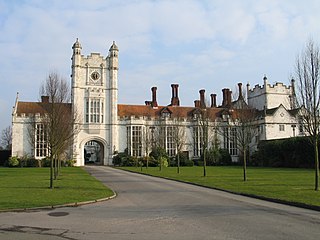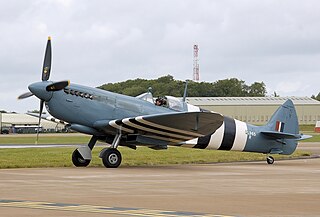History
The Aircraft Operating Company Ltd (AOC) was founded by Harold Hemming AFC (also known as Major 'Lemnos' Hemming), a former Royal Flying Corps pilot, aerial survey pilot and amateur air racing pilot. Hemming was managing director, and his business partner Alan S. Butler was chairman of the board. [1] [2] In 1925, AOC took over Aerofilms Ltd, and continued to employ Francis L. Wills as managing director of that company, that expanded its operations based at Hendon. [3]
In 1925, Ordnance Survey awarded to AOC the first contracts for the development of aerial photography in the production of its surveying and map-making operations. Throughout the 1920s and 1930s, AOC was employed by Ordnance Survey for surveying in many British overseas colonies in the Middle East, Africa, Asia, etc. Contracts were also obtained from foreign governments such as Brazil for similar work. [4] [5] [6]
In the 1920s, AOC owned and operated various aircraft, such as Airco DH.9A and Vickers Vendace, but it identified a need for an aircraft designed specifically optimised for aerial surveying and photography. The result was the Gloster AS.31 Survey, a development of the De Havilland DH.67 design project. Starting in 1930, AOC used a Gloster Survey for aerial surveying in southern Africa, where a sister company was formed, Aircraft Operating Company of Africa (Pty.) Ltd. [7] [8] [9] [10] [11]
In 1933, AOC and Aerofilms were incorporated in a new company, H. Hemming and Partners. AOC established its headquarters in Wembley, Middlesex. [1]
In 1938, AOC purchased a Swiss-made Wild A5 Autograph photogrammetric plotting machine that could minimise the effects of optical distortion and perspective in magnified aerial photographs. In early 1939, Sidney Cotton employed the facilities of AOC for production and interpretation of both vertical and oblique aerial photographs taken of ground installations in Germany and elsewhere in clandestine flight operations. [12] [13] [14]
On 31 May 1940, the staff and equipment of AOC were requisitioned by the Air Ministry. Hemming became a squadron leader, later wing commander; expert AOC photographic interpreter Michael Spender was joined by new RAF personnel headed by Squadron Leader Walter Heath. Operations continued to expand at the Wembley head office (nicknamed 'Paduoc House') under the title Photographic Development Unit (Interpretation) (or PDU(I)), as a companion unit to No.1 PDU headed by Sidney Cotton. Formal training of many photographic interpreters (PIs) took place at Wembley, particularly of WAAF staff, including Constance Babington Smith. On 11 July 1940, the unit was renamed Photographic Interpretation Unit. On 2 October 1940, the main factory at Wembley suffered major damage from aerial bombing. On 7 January 1941, the unit was renamed Central Interpretation Unit, and operations were progressively transferred to a new headquarters at Danesfield House in Buckinghamshire, also known as RAF Medmenham; the transfer was completed on 23 May 1941. [12] [13] [14] [15] [16]
In 1944, Percy Hunting, who was a major shareholder in AOC, formed a new company Hunting Aerosurveys Ltd for the purpose of carrying out civilian commercial surveying via aerial photography. Hunting Aerosurveys took over the Aircraft Operating Company, and Aircraft Operating Company was no longer used as a brand. However, its subsidiary Aerofilms continued as a named resource for aerial photographs, and its co-founder Francis Wills went on to become managing director of Hunting Aerosurveys. [16]

Imagery intelligence (IMINT), pronounced as either as Im-Int or I-Mint, is an intelligence gathering discipline wherein imagery is analyzed to identify information of intelligence value. Imagery used for defence intelligence purposes is generally collected via satellite imagery or aerial photography.

Aerial photography is the taking of photographs from an aircraft or other flying object. Platforms for aerial photography include fixed-wing aircraft, helicopters, unmanned aerial vehicles, balloons, blimps and dirigibles, rockets, pigeons, kites, parachutes, stand-alone telescoping and vehicle-mounted poles. Mounted cameras may be triggered remotely or automatically; hand-held photographs may be taken by a photographer.

Number 3 Squadron, also known as No. 3 (Fighter) Squadron, of the Royal Air Force operates the Eurofighter Typhoon FGR4 from RAF Coningsby, Lincolnshire, since reforming on 1 April 2006. It was first formed on 13 May 1912 as one of the first squadrons of the Royal Flying Corps – being the first to fly heavier than air aircraft.

The Gloster Aircraft Company was a British aircraft manufacturer from 1917 to 1963.

RAF Medmenham was a Royal Air Force station based at Danesfield House near Medmenham, in Buckinghamshire, England. Activities there specialised in photographic intelligence, and it was once the home of the RAF Intelligence Branch. During the Second World War, RAF Medmenham was the main interpretation centre for photographic reconnaissance operations in the European and Mediterranean theatres.
MI4 was a department of the British Directorate of Military Intelligence, Section 4, part of the War Office. It was responsible for aerial reconnaissance and interpretation. It developed into the JARIC intelligence agency. The present day successor agency to MI4 is the Defence Intelligence Fusion Centre.

Frederick Sidney Cotton OBE was an Australian inventor, photographer and aviation and photography pioneer, responsible for developing and promoting an early colour film process, and largely responsible for the development of photographic reconnaissance before and during the Second World War. He numbered among his close friends George Eastman, Ian Fleming and Winston Churchill.
Aerofilms Ltd was the UK's first commercial aerial photography company, founded in 1919 by Francis Wills and Claude Graham White. Wills had served as an Observer with the Royal Naval Air Service during World War I, and was the driving force behind the expansion of the company from an office and a bathroom in Hendon to a business with major contracts in Africa and Asia as well as in the UK. Co-founder Graham-White was a pioneer aviator who had achieved fame by making the first night flight in 1910.

The Percival Pembroke is a British high-wing twin-engined light transport aircraft built by the Percival Aircraft Company, later Hunting Percival.
Hugh Hamshaw "Ham" Thomas, MBE, FRS, FLS,, was a British paleobotanist.

Aerial reconnaissance is reconnaissance for a military or strategic purpose that is conducted using reconnaissance aircraft. The role of reconnaissance can fulfil a variety of requirements including artillery spotting, the collection of imagery intelligence, and the observation of enemy maneuvers.

602 Squadron is a Royal Auxiliary Air Force squadron. Originally formed in 1925 as a light bomber squadron, its role changed in 1938 to army co-operation and in 1939 to that of a fighter squadron.
Squadron Leader John Hugh Saffery (1907–1985) was an officer of the British Royal Air Force during World War II, who served as flying instructor for glider pilots and then commanded a photo reconnaissance squadron. Post-war became a survey pilot for Hunting Aerosurveys Ltd.

Hunting Aerosurveys Ltd was a British aerial photography company. Its operations became more diversified under the name Hunting Surveys.
No. 1 Photographic Reconnaissance Unit was a flying unit of the Royal Air Force, first formed in 1940.

Operation Pike was the code-name for a strategic bombing plan overseen by Air Commodore John Slessor against the Soviet Union by the Anglo-French alliance. British military planning against the Soviet Union occurred during the first two years of the Second World War, when, despite Soviet neutrality, the British and French came to the conclusion that the German–Soviet pact made Stalin an accomplice of Hitler. The plan was designed to destroy the Soviet oil industry to cause the collapse of the Soviet economy and deprive Germany of Soviet resources.

The F24 camera is a 1920s British camera used for aerial reconnaissance by British and Allied armed forces into the mid-1950s. It is widely and erroneously referred to as F.24 or F-24.
Group Captain Frederick Charles Victor Laws, was an officer in the Royal Air Force, an aerial surveyor, and the founder and most prominent pioneer of British aerial reconnaissance.

A transformational growth in air reconnaissance occurred in the years 1939–45, especially in Britain and then in the United States. It was an expansion determined mostly by trial and error, represented mostly by new tactics, new procedures, and new technology, though rarely by specialized aircraft types. The mission type branched out into many sub-types, including new electronic forms of reconnaissance. In sharp contrast with the case during the pre-war years, by 1945 air reconnaissance was widely recognized as a vital, indispensable component of air power.
The Defence Intelligence Fusion Centre (DIFC) is based at RAF Wyton in Cambridgeshire. Largely created from the staff of the National Imagery Exploitation Centre and then known for several years as the Defence Geospatial Intelligence Fusion Centre, it can trace its history back to clandestine reconnaissance operations at the beginning of the Second World War by Sydney Cotton on behalf of MI6 and then MI4, and the formation of the Allied Central Interpretation Unit at RAF Medmenham. Today, DIFC's role has grown beyond just imagery intelligence. Part of the Joint Forces Intelligence Group (JFIG) within Defence Intelligence, DIFC's primary role is to support Defence planning, current operations and the intelligence assessment process. DIFC still provides specialist imagery intelligence, but also conducts multi-disciplinary intelligence fusion for the armed forces and other UK Government partners. The integrated multi-disciplinary Task Groups at DIFC use data and reporting from various sources, together with other advanced technologies, to provide critical information and over-watch to tactical, operational and strategic decision makers. DIFC is a joint service and civilian organisation under the command of an RAF Group Captain.













